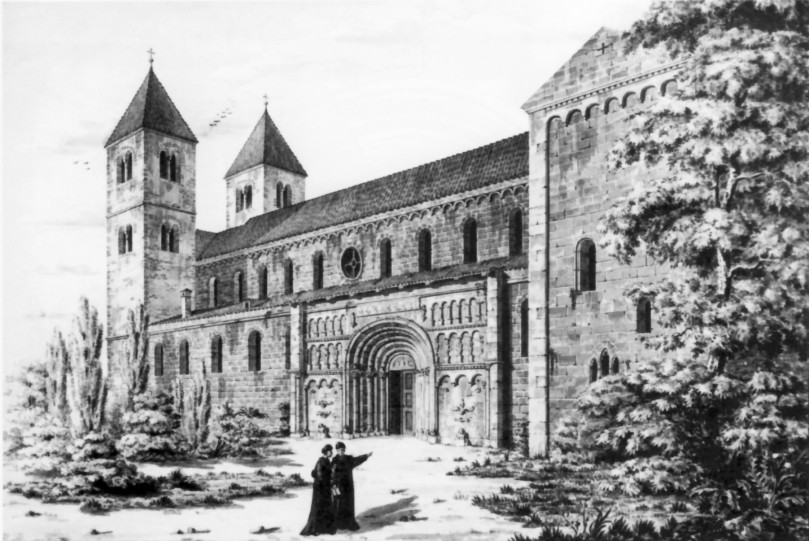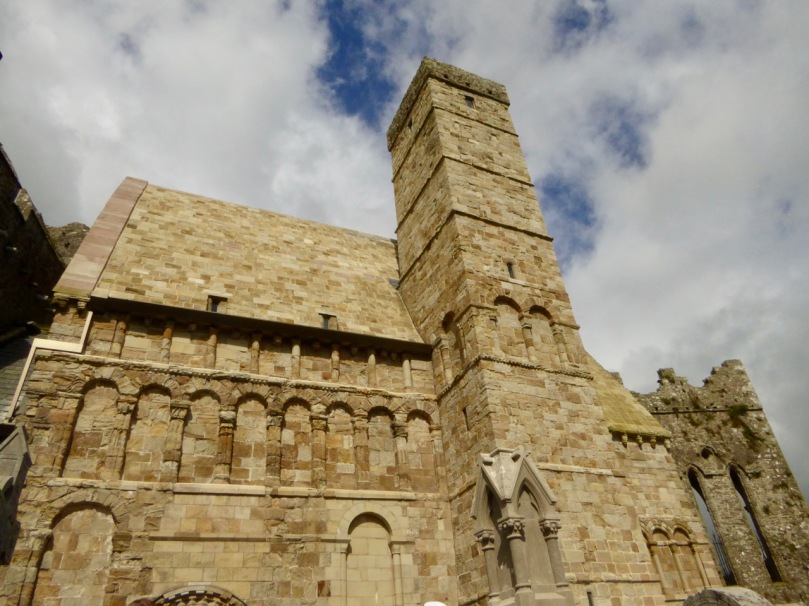Cormac’s Chapel on the hill of Cashel is the jewel in the crown of Irish Romanesque architecture. It also allows us to trace the influences and development of the Irish Romanesque style both to other examples inside Ireland and to models outside of Ireland. Now that the church has been cured of its chronic leakage problems and the scaffolding has been taken down, we can finally look at this wonderful building in its entirety. In doing so I rely heavily on the work of Prof Tadhg O’Keefe.*
On a walking tour of Bavaria a couple of years ago we visited this church, which turns out to have been connected with Cormac’s Chapel in a surprising way. This incredible portal is completely enclosed by a glass frame to protect it from the weather
We know from historical records exactly when Cormac’s Chapel was started (1127) and when it was consecrated (1134). This means that it was not the high point (that is, the latest and most elaborate development) of Irish Romanesque, but in fact quite early in the sequence of buildings that constitute the corpus of Irish Romanesque architecture. We can look back to the early churches we examined in Irish Romanesque – an Introduction for antecedents, but in many ways this is not a ‘typical’ Irish Romanesque structure. It is, in fact, more reliant for its influences on Anglo-Norman churches in England and Wales, and on the important ecclesiastical links between Cashel and modern-day Germany. O’Keefe puts it this way:
This is the one building of that era in Ireland which must surely belong in the European canon of great Romanesque architectural essays; with a floor area less than the size of a tennis court it is also one of the smallest.
With the scaffolding finally removed, we can see the full extent of the chapel
Who was Cormac? Cormac Mac Cárrthaig (McCarthy) was King of Munster from 1123 to 1127, when he was deposed and retired to be a monk in Lismore with St Malachy (the man credited with reforming Irish monasticism and inviting in the Cistercians). His throne was restored to him within a few months and in gratitude he commissioned a new chapel to be built on the Rock. While the Rock of Cashel had been gifted to the church previously, the chapel was probably intended to serve the purpose of a royal inauguration site, thus enhancing and securing Cormac’s power. It took some time to build – it was consecrated seven years later.
In this photograph, note particularly the high pitched roof and the tiny windows that are the only means of letting light in to the rooms above the chancel and above the nave. Note also how the later gothic cathedral impinges on the much smaller chapel
Let’s start on the outside. This is a nave and chancel church, with opposing doors on the north and south sides, twin square towers, steeply pitched stone roof, projecting altar bay, and extensive string coursing and blind arcading on the exterior walls. The pitched stone roof appears to be a typically Irish feature – similar examples have survived intact in St Kevin’s Kitchen in Glendalough, St Flannan’s Oratory in Killaloe, and in St Colmcille’s House in Kells (see Robert’s post A Medieval Feast), while we saw vestiges in Kilmalkedar a few months ago. In fact, the roof accommodates a second story, accessed via a stairway within the church. You can see the tiny round-headed windows that give light to this space on the wall above the chancel, and there are also rectangular windows right at the bottom on the roof where it meets the wall of the nave. It must have been an uncomfortable room, dark and damp, and it is hard to imagine it being used for daily activities (such as a Scriptorium, as the Kells room was traditionally thought to have been) so it has been suggested that it was a sacristy.
St Flannan’s Oratory in Killaloe, Co Clare. As in Cormac’s Chapel, the steeply pitched gable accommodated a room above the chancel, in this case lit by a single window in the end wall
But that pitched roof is where the older Irish influences stop – for the rest of the building we must look elsewhere.
Intriguing carvings on the portal of the Regensburg church
The two square towers are particularly interesting and have few parallels in Ireland. In fact, they are based on a church we happen to have visited two years ago in Regensburg (previously called Ratisbon) in Bavaria. Upon his restoration as King of Munster, Cormac received a visit from two Ratisbon monks, Isaac and Gervasius, accompanied by a carpenter (Conrad) and one other man.
Detail from the St Albert of Cashel window by Harry Clarke in the Honan Chapel, at University College, Cork: Albert preaching to the (red-haired) people of Ratisbon
The first evangelising monk from Cashel to establish links with Ratisbon had been St Albert, way back in the 700s and there had been strong connections ever since. The church, St James, in Regensburg, is called the Scots Church or Schottenkirche (Schotte was the term used for Irish) and while it has been altered over the centuries, the Romanesque core remains, along with the two flanking towers and a magnificent doorway in the north wall.
Conrad the Carpenter and his sidekick may well have put to use the knowledge they acquired building the Schottenkirche St Jakob in designing the two square towers at Cormac’s Chapel.
This photograph illustrates the altar projection on the east end of the chancel, as well as the two towers. Note the conical cap on the north tower, as in the Regensburg example
Opposing doors in the north and south walls are almost unknown from older Irish contexts, as it was customary to enter through the west end (opposite end to the altar). We saw opposing doors in Liathmore but O’Keefe feels they may be a bi-product of later reconstruction. There are reports of a two-door church of St Brigid in Kildare, and such designs…
were presumably designed to accommodate different types of procession, sometimes simultaneously: royal and episcopal parties certainly entered through the large portal on the north side, while clerical concelebrants and choristers presumably entered through the smaller portal in the south wall.
And wonderful doors they are! (Look back at Irish Romanesque 2 – Doorways for more about doors in general.) The south door is now the main entrance for visitors but in fact is relatively modest with only two orders and a timpanum depicting a animal, probably a lion. The archivolts are chevroned but weathering has damaged much of the other carvings.
The cathedral wall cuts off part of this doorway, damaging the door and making photography difficult. This is a small open triangular space between the cathedral wall and the north door
The north door is larger and more elaborate, although it is incomplete, as the later gothic cathedral was built up against this section of the chapel. Above the door is a triangular pediment, decorated with vertical and horizontal chevroned lines and with rosettes.
From Irish Pictures Drawn with Pen and Pencil, Richard Lovett 1888
The tympanum has a curious decoration – it’s a centaur, of all things, shown hunting a large lion with a bow and arrow. This is not unknown in Romanesque carvings, which often feature animals from the medieval bestiary, but unusual enough.
As for the rest of the chapel, Prof O’Keefe points to the most likely influence being the Anglo-Norman churches of England and Wales, which provide exact parallels for many of the features, external and internal, that can be observed at Cormac’s Chapel. One feature he points to, for example, is the shallow projection, lit by lateral windows, at the far east end of the church – functioning as an extension of the chancel to contain the altar. Indeed, muses O’Keefe, as he ponders the particular mixture of Irish and non-Irish features visible in this building;
Walking around Cormac’s Chapel, outside and inside, one instantly recognizes that it has affinities in Britain. The blind arcading and the chevrons can be paralleled effortlessly in literally hundreds of English Romanesque contexts, from south Wales to East Anglia, and from Exeter to Dundee (Fig. 78). Moreover, their execution speaks not of Gaelic-Irish craftsmen who have learned these forms and how to carve them but of actual English Romanesque craftsmen in Cashel in the late 1120s and early 1130s. We cannot prove this, of course, but later Romanesque work in Ireland looks sufficiently different for us to be very confident that Anglo-Norman hands recreating an English Romanesque repertoire shaped large parts of Cormac’s Chapel.
Blind arcading, string courses, and carved roof corbels (see below) enliven the outside of the chapel. The two small windows in the roof allow light to the room above the nave
Next week we will go inside Cormac’s Chapel and discover yet more treasures from the 12th century. See you back here then.
*Prof O’Keefe’s book is now out of print although second-hand copies can be found. I relied heavily on his manuscript, Romanesque Ireland: Architecture and Ideology in the Twelfth Century, which he has generously uploaded to Academia.















The destruction of the adjoining building and later medieval windows was a cultural crime.All phases of a monuments history are equally valid.ICMOS Rules.
LikeLike
Thanks for this, Michael. Must investigate this further.
LikeLike
The only thing that would/could make these pieces better is a map and/or some indication of where you are. Also, someday I hope you write about the church at Castletownshend — that of the Ladies who wrote about the Irish R. M.
LikeLike
Hi Jinny – thanks for these comments. I thought about including maps, but then thought that most people seem to just google locations nowadays if they are unsure. I have done a couple of posts about Castletownsend. See this one https://roaringwaterjournal.com/2015/08/10/the-gift-of-harry-clarke/ for example. And it’s mentioned here and there: https://roaringwaterjournal.com/category/west-cork/castletownshend/
LikeLike
Interesting image of the altar projection where a pitched roof has clumsily cut across the arcading. Being annoyingly pedantic, isn’t it a ‘pyramidal’ roof on the tower, not a conical one?
LikeLike
That seems to be a later intrusion, now gone. and yes, you are right pyramidal is the correct term. Future readers, take note!
LikeLike
How nice to see it with the scaffolding finally down and what a great job has been made of cleaning and restoring it. A remarkable building.
LikeLike
Yes, it was wonderful to see it emerge all shining!
LikeLike